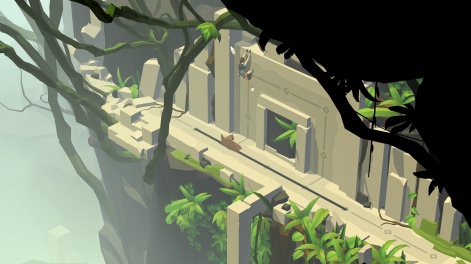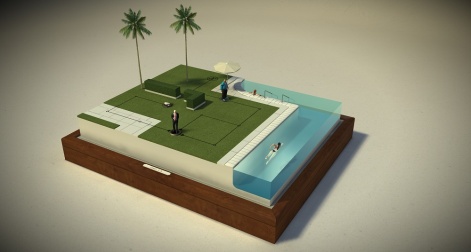As technology advances, video games are becoming more and more impressive. Leaps in graphic capability and design paired with stunning sound has seen games rival the big screen in recent years.
However, creating beautiful games for handheld devices can be challenging - it’s a task in itself to design captivating worlds, levels and stories with the limitations of mobile hardware and a tiny screen to view it on.
That’s not an impossible barrier to break, and the art team at Square Enix Montréal is one that won’t be remotely stifled by the limitations of mobile design. In fact, it just means that the team has an opportunity to challenge what “beautiful” means, outside of the hyper-realism that today’s AAA titles thrive on.
PocketGamer.biz chatted to three members of Square Enix Montréal design team to get their insight on how to craft gorgeous games you can carry in your pocket. Danny Lucá, presentation director, Cris Nieto, art director, and Oceane Costantini, lead UI artist, have all contributed their thoughts on the main differences between mobile and console art direction, and the biggest challenges faced when it comes to showcasing grand experiences on mobile.
PocketGamer.biz: To start off, how would you define “beautiful” in terms of game art?
Danny Lucá: Video games are a perfect blend of technology and traditional art forms: sculpture, illustration, narrative and music. The visual graphics are only one of many components. While a refreshing color palette, unique shapes and patterns, immersive effects and subtle lighting can create some spectacular visuals, I believe the beauty truly comes together when the visuals work cohesively with the narrative, audio and game play to enhance the overall experience.
Cris Nieto: Game art in modern times has taken on such an astonishing new dimension of complexity and richness. Constant innovations are rapidly bridging that gap between what we perceive as real and what is computer-generated. Modern gaming now represents the richest level of engagement and immersion that goes beyond any medium to date, and that experience is improving at a mind-blowing pace.
However, while technological advancement is allowing for more abundant, brighter, juicier, and faster pixels, beauty is still the simple pursuit of harmony.
Oceane Costantini: I think the beauty of a game lies in its consistency, you have to enter a universe, create an emotion. The environments, characters, interfaces, music, VFX etc. Everything must form ONE. I love when a game takes me to a particular mindset, that's when the magic happens.

Do you think you can evoke "beauty" (however you define it) without needing hyper-realistic art?
Danny: Totally. Hyper-realism is an art style, not a necessity for beauty. While some studios have been pushing to blur the lines between digital world and reality, others have embraced a more stylized aesthetic approach. Both work. For example, you can create beauty with minimalistic forms just by the way they move. There’s elegance in simplicity as long as the style, whether it’s realist or minimalist, can convey emotions and create reactions in unforgettable events, one is able to evoke beauty.
Cris: Beauty can come from even the simplest forms. A single thoughtful, well-executed stroke can evoke a strong emotional response and be considered beautiful within the right context.
While a lot of games employ hyper-realistic graphics, there are equally beautiful games that use a more cartoony approach, black and white approach, or a bold flat 2D approach. There are many styles to modern games, and many do them very well.
As an artist, the gaming platform, be it console or mobile, presents a variety of challenges. It is through the thorough and careful understanding of those challenges, based on the target device, that we can curate an optimized experience that curtails those challenges and presents an interactive experience that is both rich and fulfilling.
Oceane: 200 per cent yes! I understand that we are trying to get closer to reality and some games are impressive from that point of view, but I call it a more technical prowess. On a beauty level, I think we should stay away from it. Art is also about reinventing what already exists, interpreting it from a new perspective, we should not hesitate to explore other styles, to be inspired by what surrounds us: visual art, culture, branding! I want to dive into a new universe... not for it to be in a copy of mine.
What do you think is the main difference between creating art for PC/console games and mobile games?
Danny: In my opinion, one of the biggest differences is the player experience. On a console or PC, the expectation is that a player’s attention is solely focused on the game. Whereas on mobile games, the player can have divided attention since they can be commonly played on the go. Creating engagement knowing that the player’s environment can be less than ideal requires extra attention to details such as feedback and cues, which can sometimes impact the way the art is experienced.
A console game is developed with a single specific, high-end hardware in mind, and is optimised for best performance on that device.
Mobile gaming requires a more calculated and strategic approach to all aspects of the game development, as the game needs to run on a variety of devices, all with a wide range in resolutions and ratios and capacities with a variety of hardware and software limitations.
As a team, we are dedicated to crafting an experience that is as engaging in the worst-case hardware scenarios, as well as the ideal case scenarios. We strive to provide the highest degree of engagement and immersion possible, while also reaching out to the widest audience possible.
Oceane: Console and PC games are often labeled as being targeted towards sophisticated gamers. What I love about mobile is the universal aspect. We have the chance to reach a large audience and change things on a larger scale. In my field more specifically (UI / UX) the intuitive and ergonomic aspect is even more interesting. The new phones have changed the way we interact and communicate in our society. I think that today we are lucky to be able to be part of this change by offering not just different games, but also experiences that come to connect to our daily lives.

What has been the biggest challenge when creating art for mobile games, and how have you overcome this?
Danny: Aside from the obvious hardware limitations, one of the biggest differences for artists and developers are the screen sizes. Although devices are getting larger each year, ensuring the art is crisp and legible on smaller screens is a thorough job. Testing early and often on devices will help set quality benchmarks and avoid any unwanted surprises down the line.
Another big difference is the sheer number of devices that are supported. With all the different restrictions, parameters, form factors and low-end devices, developers are consistently looking for ways to creatively reduce memory and CPU cost without sacrificing quality. This is also the case for UI elements. There’s a need to be extremely vigilant in how screens are built to minimise impact on performance while being able to create appealing visuals. It’s a constant and evolving challenge for developers and artists to make sure the experience is as loyal as possible to the original design, no matter the device used.
Square Enix Montréal's unique take on mobile development makes it a little gem of a studio. They combine a perfect mix of indie creativity and collaboration, mixed with AAA aspiration.Danny Lucá
Cris: How to make that tiny screen feel huge.
Balancing all aspects is the key to overcoming the restrictions of mobile gaming art. Finding the right balance of visual details vs performance and using the tools available to emphasise what we want the player to focus on.
Oceane: I’ve come a long way... I started developing for mobile when the iPhone didn't exist yet. There has been enormous progress and we’ve had to adapt quickly. First, the constraints were quite different, the integration was done in an archaic way, we worked with a maximum number of colours. We were much more dependent on programmers and quite artistically limited. Today, with the new engines, a new world is opening to us. The artists have become very technical! The production methods and tools have changed the way we work for the better!
What excites you most about working on games at Square Enix Montreal?
Danny: Square Enix Montréal's unique take on mobile development makes it a little gem of a studio. They combine a perfect mix of indie creativity and collaboration, mixed with AAA aspiration. The teams are relatively small which produces a unique, creative and familial vibe with all the support needed to create memorable games.
Cris: I work with an extremely talented and experienced group of artists and programmers that understand the complexities of working in such a demanding environment.
Square Enix Montréal is a smaller studio, but it is making a huge mark on the industry. SEM has a keen understanding of the challenges and adversities mobile game developers face, and they provide the tools and learning we need to bring our games to life.
Oceane: Square Enix Montréal stands out for its desire to do things differently. I like that we explore new technologies, that we dare to use less conventional styles. We dare to take risks and all of that comes with new challenges… it pushes us to question ourselves and be ever more creative.
Do you think advancements in hardware will lead to games becoming "more beautiful"?
Danny: Better hardware means more possibilities. However, this doesn’t necessarily mean games will be more beautiful because of realistic graphics. In 10 years, we will look back and realize that the timeless games were the ones that offered simpler yet stylized aesthetics and managed to deliver a cohesive experience, probably without even reaching their hardware limits.
Cris: Folding devices, insane aspect ratios, ultra high definition screens, heart-pounding frames-per-second, multiple forms of interactions like AR & VR, the future of gaming is incredibly exciting, and the possibilities are limitless.
Oceane: Without a doubt. Just look at what we can do today with our mobile devices, the technology has not finished impressing us. We are far from having seen it all!





















